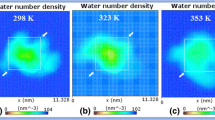Abstract
Amino acids such as proline are known as natural osmolytes that can stabilize proteins. But, there is no distinct mechanism at the molecular levels that can explain the stabilization effects of such osmolytes. In this paper, for the first time, the molecular level mechanism of protein stabilization by amino acid proline was studied using molecular dynamics simulation, which led to the following interesting points. Simulations were performed at room and high temperatures using lysozyme as a protein model. Although lysozyme was partially unfolded in the aqueous solution at high temperatures, the structure remained relatively native in the presence of 3 mol·L−1 proline. Protein residues showed slower dynamics in aqueous proline solution than that in water. These results are in agreement with experimental observations that show enhanced protein thermal stability in the presence of proline. It was also found that proline molecules are excluded from the protein surface and water molecules in the hydration shell around the protein increase, thus inducing thermodynamic stabilization of the protein. Moreover, it was shown that proline molecules form molecular aggregates in the solution, in agreement with previous experimental observations. We found that these aggregates can increase the order of water molecules and also the water–water hydrogen bond strength. This also leads to higher thermal stability of the protein in such solutions. The results of this paper shed some light on the molecular mechanism of protein stabilization by natural amino acids.







Similar content being viewed by others
References
Yancey, P., Clark, M., Hand, S., Bowlus, R., Somero, G.: Living with water stress: evolution of osmolyte systems. Science 217(4566), 1214–1222 (1982)
Yancey, P.H.: Water stress, osmolytes and proteins. Am. Zool. 41(4), 699–709 (2001)
Arakawa, T., Timasheff, S.N.: The stabilization of proteins by osmolytes. Biophys. J. 47(3), 411–414 (1985)
Kar, K., Kishore, N.: Enhancement of thermal stability and inhibition of protein aggregation by osmolytic effect of hydroxyproline. Biopolymers 87(5–6), 339–351 (2007)
Sepasi Tehrani, H., Moosavi-Movahedi, A.A., Ghourchian, H., Ahmad, F., Kiany, A., Atri, M.S., Ariaeenejad, S., Kavousi, K., Saboury, A.A.: Effect of compatible and noncompatible osmolytes on the enzymatic activity and thermal stability of bovine liver catalase. J. Biomol. Struct. Dyn. 31(12), 1440–1454 (2012)
Wang, A., Bolen, D.W.: Effect of proline on lactate dehydrogenase activity: testing the generality and scope of the compatibility paradigm. Biophys. J. 71(4), 2117–2122 (1996)
Shukla, D., Schneider, C.P., Trout, B.L.: Molecular level insight into intra-solvent interaction effects on protein stability and aggregation. Adv. Drug Deliv. Rev. 63(13), 1074–1085 (2011)
Housaindokht, M.R., Bozorgmehr, M.R., Monhemi, H.: Structural behavior of Candida antarctica lipase B in water and supercritical carbon dioxide: a molecular dynamic simulation study. J. Supercrit. Fluid 63, 180–186 (2012)
Monhemi, H., Housaindokht, M.R.: How enzymes can remain active and stable in a compressed gas? New insights into the conformational stability of Candida antarctica lipase B in near-critical propane. J. Supercrit. Fluids 72, 161–167 (2012)
Artymiuk, P.J., Blake, C.C.F., Rice, D.W., Wilson, K.S.: The structures of the monoclinic and orthorhombic forms of hen egg-white lysozyme at 6 Ångstroms resolution. Acta Crystallogr. B 38, 778–783 (1982)
Lindahl, E., Hess, B., van der Spoel, D.: A message-passing parallel molecular dynamics implementation. Comput. Phys. Commun. 91, 43–56 (1995)
Gunsteren, W.F.V., Billeter, S.R.B., Eising, A.A., Hunenberger, P.H., Kruger, P., Mark, A.E., Scott, W.R.P., Tironi, I.G.: Biomolecular Simulations the GROMOS96 Manual and User Guide. VdF Hochschulverlag ETHZ, Zurich (1996)
Darden, T., York, D., Pedersen, L.: Particle mesh Ewald: an Nlog(N) method for Ewald sums in large systems. J. Chem. Phys. 98, 10089–10092 (1993)
Hess, B., Bekker, H., Beredensen, H.J.C., Faraaije, J.E.M.: LINCS: a linear constraint solver for molecular simulations. J. Comput. Chem. 18, 1463–1472 (1997)
Miyamoto, S., Kollman, P.A.: SETTLE. An analytical version of the SHAKE and RATTLE algorithms for rigid water models. J. Comput. Chem. 13, 952–962 (1992)
Berendsen, H.J.C., Postma, J.P.M., van Gunsteren, W.F., DiNola, A., Haak, J.R.: Molecular dynamics with coupling to an external bath. J. Chem. Phys. 81, 3684–3690 (1984)
Vagenende, V., Yap, M.G.S., Trout, B.L.: Mechanisms of protein stabilization and prevention of protein aggregation by glycerol. Biochemistry 48(46), 11084–11096 (2009)
Vagenende, V., Yap, M.G.S., Trout, B.L.: Molecular anatomy of preferential interaction coefficients by elucidating protein solvation in mixed solvents: methodology and application for lysozyme in aqueous glycerol. J. Phys. Chem. B 113(34), 11743–11753 (2009)
Lee, J.C., Timasheff, S.N.: The stabilization of proteins by sucrose. J. Biol. Chem. 256(14), 7193–7201 (1981)
Arakawa, T., Timasheff, S.N.: Stabilization of protein structure by sugars. Biochemistry 21(25), 6536–6544 (1982)
Lins, R.D., Pereira, C.S., Hünenberger, P.H.: Trehalose–protein interaction in aqueous solution. Proteins 55(1), 177–186 (2004)
Zhang, N., Liu, F.-F., Dong, X.-Y., Sun, Y.: Molecular onsight into the counteraction of trehalose on urea-induced protein denaturation using molecular dynamics simulation. J. Phys. Chem. B 116(24), 7040–7047 (2012)
Rudolph, A.S., Crowe, J.H.: A calorimetric and infrared spectroscopic study of the stabilizing solute proline. Biophys. J. 50(3), 423–430 (1986)
Srinivas, V., Balasubramanian, D.: Proline is a protein-compatible hydrotrope. Langmuir 11(7), 2830–2833 (1995)
Samuel, D., Ganesh, G., Yang, P.-W., Chang, M.-M., Wang, S.-L., Hwang, K.-C., Yu, C., Jayaraman, G., Kumar, T.K.S., Trivedi, V.D., Chang, D.-K.: Proline inhibits aggregation during protein refolding. Protein Sci. 9(2), 344–352 (2000)
Acknowledgments
We gratefully acknowledge financial support from the Islamic Azad University, Mashhad Branch.
Author information
Authors and Affiliations
Corresponding author
Rights and permissions
About this article
Cite this article
Bozorgmehr, M.R., Monhemi, H. How Can a Free Amino Acid Stabilize a Protein? Insights from Molecular Dynamics Simulation. J Solution Chem 44, 45–53 (2015). https://doi.org/10.1007/s10953-015-0291-7
Received:
Accepted:
Published:
Issue Date:
DOI: https://doi.org/10.1007/s10953-015-0291-7




